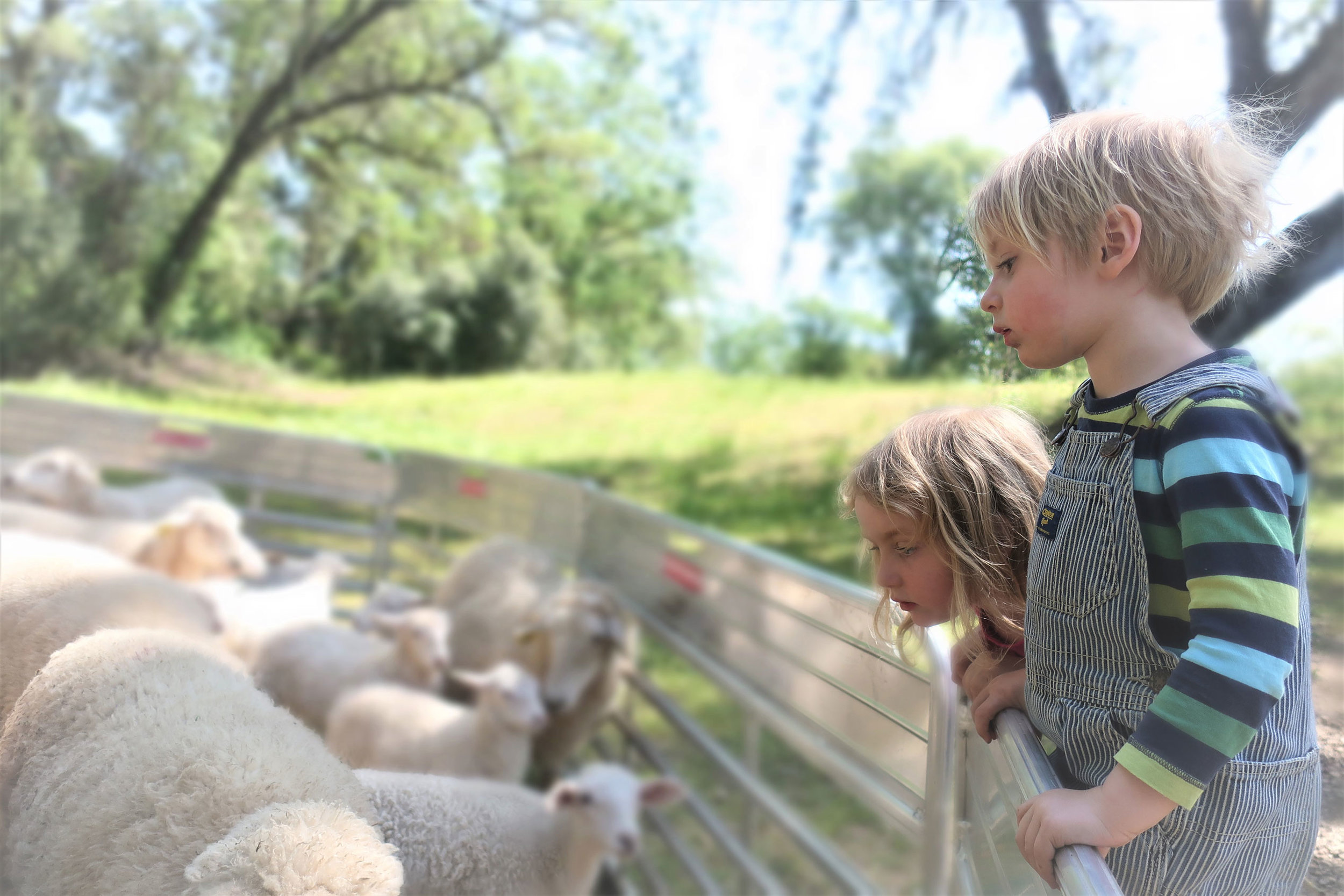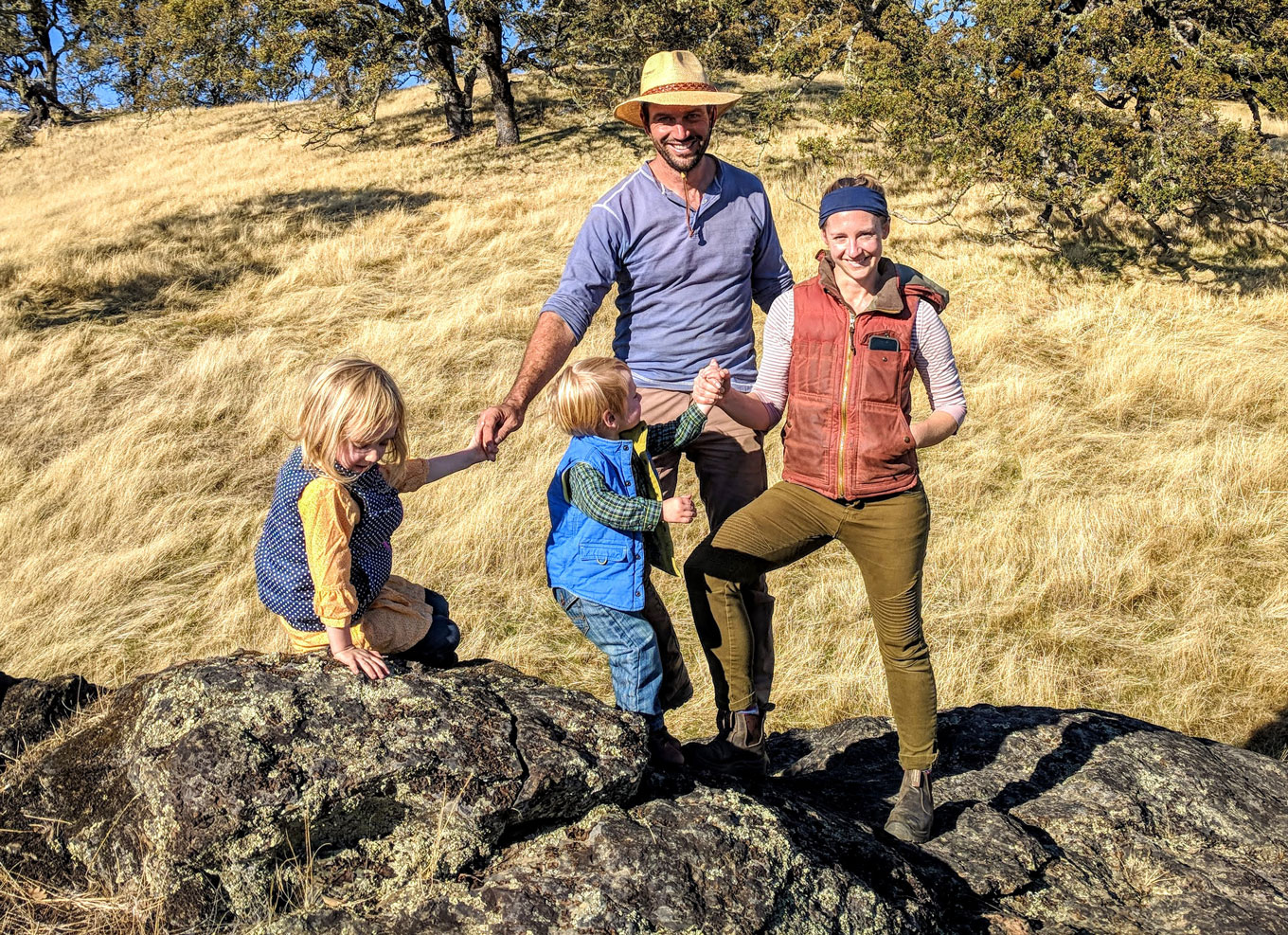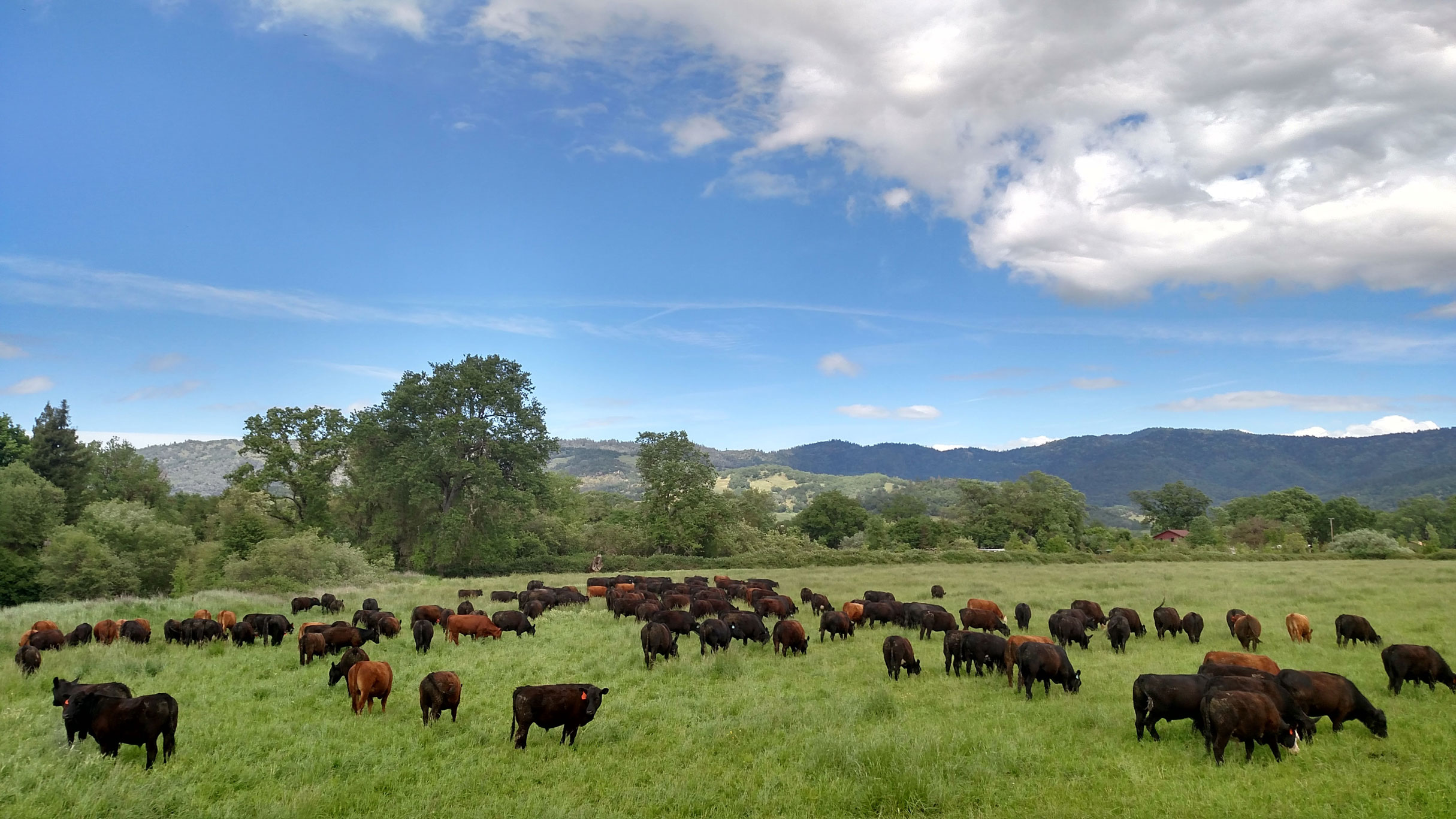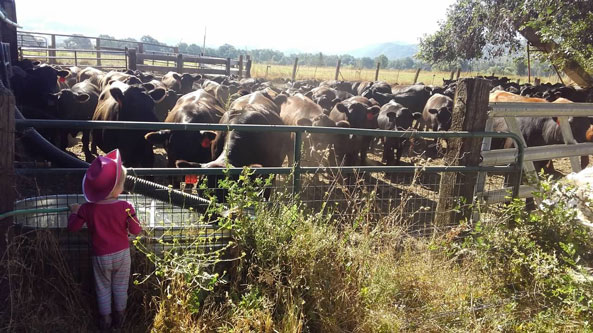Six Generations Strong

Magruder Ranch Turns 100
by Kyle Farmer
A new swing hangs from old chains. The live oak, which holds the swing on its stately branches, has already re-grown at least once from a stump. My daughter’s tiny hands hold fast to the same cold links her mom’s once did. Her blue eyes beam with the thrill, and I catch her again and push her gently forward. “I’m taller than you!“ she squeals, and in a way she is right. For a transient moment, thanks to that great big tree and her grandfather’s chains, a green toddler swing and a push of my arm, she is taller than us all.
This year, Ingel-Haven Ranch turns 100. Though many of you might know us as Magruder Ranch, our land, still named after the first two generations to call it home, is called Ingel-Haven. This year we celebrate its centennial, but as I push the sixth generation to live on this land on this new swing with old chains, I am not just thinking about the last 100 years—I am thinking about the next.
If you are one of those Americans who pays attention to the same media sources that I do, there is, at the moment, a collective yowl, a lament for our children's future. The Earth, we read, will soon be “uninhabitable.“ The “Human Game,“ writes Bill McKibben, has “begun to play itself out.“ This is a hard thing to stomach as you push your almost-kindergartener on her swing.
These dire predictions haunt my thoughts as I consider the small green hut adorned with a large crescent moon situated next to the stately Victorian that serves as the headquarters of our ranch. The west-facing wall is full of bees. Another wall holds a few generations' worth of saddles. In the winter, this little hut is piled full of inner tubes and beach chairs, hibernating until spring.
These are the quarters my son and daughter’s great-great-great-grandfather built to live in while orchestrating the construction of the Big House next door. It is a reminder that progress frequently relies on a series of small steps, and it is emblematic of our stewardship of the land. There is not a crop or species of livestock we have raised for market that we did not first experiment with on a homestead scale. At today's Magruder Ranch, we don't invest in a new irrigation system without trying it out on a few acres first to iron out the kinks. Our approach to agriculture and land management is based on constant experimentation and adaptation. We aren’t afraid to try something new, but when we do, we will likely build it out of old parts.
There is a balance between honoring a legacy and adapting to the future. After two generations of raising sheep, my wife’s grandmother and grandfather sold the whole flock, observing that “sheep wake up each morning and try to die, and you wake up and try to save them.“ Instead, they planted pears, a tree crop better suited to our heavy wet soils than most but highly susceptible to frost and to the whims of a cosmetically obsessed consumer market. Pear trees, it seems, might not wish to die, but they do dream of wormholes. So after a childhood spent caring for those trees, lighting smudge pots by night and refilling them with diesel fuel by day, my father-in-law, Mac Magruder, quite literally took a bulldozer to a portion of his heritage, and instead focused on what the land had always seemed to want to grow. Grass.
There is perhaps no better example of the art of experimentation and adaptation than the reluctant rancher himself, Mac Magruder. A ceramic artist by avocation and training, Mac made the difficult decision to return home to manage the ranch at the age of 27, when his father fell ill. Dissatisfied with a volatile cattle market and, like any artist, unenthusiastic about allowing others to put the finishing touches on a calf that he had cared for from before it was born, Mac began grass-finishing his beef before “grass-fed beef“ was a thing. In fact, he helped make it a thing by giving it away to skeptical customers. After a blind taste test at Berkeley’s Chez Panisse confirmed the superiority of Mac’s approach to raising cattle, Alice Waters invented a name to put on the menu, and “Magruder Ranch“ was born.
In our hearts, though, we are still Ingel-Haven Ranch. Magruder Ranch is the way we raise our cattle, sheep, and pigs, but Ingel-Haven is this old chain and new swing. It exists and evolves no matter what crops we produce for our community, and it will continue to exist as long as there are people loving this land.
The challenges my daughter, June, and son, Walter, will face, if they choose to steward this land, are daunting. They will likely see more flooded barn lots before they reach their 40s than did all of the generations before them. Wildfires will continue to disappear a season’s worth of grass feed in an afternoon, and on bad years, fires will produce more greenhouse gases than global fossil fuel emissions. Excess carbon dioxide will continue to make grass less nutritious, and extreme weather swings will make summer pneumonia in our cattle and sheep more of a problem.
Writers and thinkers living in urban centers are full of techno-utopian fixes to the monsters we have borne. But grandiose predictions that farmers will leave the soil and move into elaborate skyscrapers with petri dishes is like a flea jumping off the back of a dog and announcing that he is off to see the world. We are that flea, and nature is that dog. The extravagant generosities of soil are our once and future wealth, and we will not begin to heal this planet until we acknowledge that debt.
There is an emerging science demonstrating that landscape and soil restoration may be our greatest hope both to adapt to and mitigate our climate crisis, which means that those of us who live in rural counties like Mendocino are sitting in the closest thing to a driver's seat that the anthropocene has to offer. At a Russian River Science Forum a couple of years ago, I was surprised to see Lorraine Flint, a climate scientist with USGS, end her presentation with the picture of a cow—not as a demon but as a solution. The science, she insisted, had progressed. Progressive grazing, forest restoration through ecologically informed thinning and prescribed fire, wetland restoration, and farming techniques that increase “the amount, the area, and longevity of the green carbon drawdown by nature,“ to quote Australian soil scientist Walter Jehne, will all play a role. All 2,243,840 acres of this county have their place in this fight.
When I watch these children of mine, their wild hair full of leaves and their hands covered in dirt, looking through toilet paper roll binoculars to identify birds whose names I didn’t know I didn't know until I was well out of college, I can’t help but feel hopeful. In We’re Doomed. Now What?, Roy Scranton argues that such optimism is its own kind of climate denial. If there is an alternative pragmatism to be offered in his last chapter, I have yet to get there. In contrast, I consider mine the optimism of an electrician who suddenly realizes that no one has yet checked the fuse box. Our entire climate change debate has taken place in an era dominated, economically and politically, by what high school economics classes call the secondary, tertiary, and quaternary sectors of the economy (manufacturing, service, and “knowledge“). The primary sector (agriculture, forestry, fishing, and mining) has been for the most part approached oppositionally through regulation and, implicitly, through offshoring. This is why good intentions have not been enough—why we have contributed more greenhouse gases to the atmosphere since the 1992 United Nations Framework Convention on Climate Change than through all of preceding human history. The first step toward conserving our forests, for example, was to protect them from mindless exploitation. But even progress can become self-defeating when it does not adapt. We will stop felling old growth western hemlocks in the Canadian Caribou Rainforest when we conjure a pricing mechanism to fund ecological and fire resiliency forest thinning here at home. Polecraft Solutions in Laytonville, for example, is building fire-adapted homes out of small diameter trees. The Redwood Forest Foundation is experimenting with biochar production. Innovations in cellulose nanocrystals could allow the stunted trees and shrubs thinned from our overburdened forests to quite literally replace plastic. Lawsuits, regulations, and traditional activism can shift the geography of exploitation, but only productive engagement with the resource sectors of the economy can secure our future.
Apologies for leading you down this rabbit hole into my own neo-agrarian economics. But to write about my children, anyone’s children, in any other way feels dishonest.
Any late season plot twist needs a wildcard, and in our case that wildcard is my kids' Great-Aunt Helen. Known to those who participated in the Redwood Valley Outdoor Education Project known affectionately as “Mother Nature,“ Helen is a biophiliac par excellence—an avid birder, a lover of plants, someone for whom ecological knowledge transcends trivia and enters into the spiritual. She prowled these hills as a child just as my wife, Grace, and sister-in-law, Martha, did; just as Mac did; and just as my kids will do once they are old enough to avoid the snakes. Her love for this land goes beyond my neophyte understanding of “love of place.“ And yet her environmentalism is complicated by the fact that she is, and will always be, a rancher’s daughter. She must hold the tension between the human need to use nature and her love of nature. She knows that the intimate knowledge of our role in the ecosystem is not a rationale to retreat from its uses but an expansion of the possibilities. I believe that when a critical mass of people holds this impossible tension in their minds, and can debate honestly and vigorously within that framework, previously unimaginable futures will arise like cream from fresh milk.
The work we are doing today involves both past and present visions and infrastructure. We are increasingly integrating Helen’s ranch vision in the form of Audubon hikes and botanical inquiries. We are augmenting Mac’s lifelong practice of prescribed fire with new partnerships and explorations of traditional ecological knowledge. Before the recent wildfires focused our attention on the patient work of recovery, we completed a Carbon Farm Plan through a partnership with the Resource Conservation District and the Carbon Cycle Institute. Rebuilding fence in the burn zones and observing the stark contrast between tree survival on the grazed and ungrazed side of the fence intensified our interest in fire grazing, culminating in a grazing collaboration among three ranches along the Willits Grade that will not only slow the spread of future fires that start along the highway, but will help to safeguard vital Mendocino County communications infrastructure on Laughlin Peak.
After ten years of experimentation with a small flock of sheep, fine-tuning our predation prevention strategies and testing the suitability of different breeds to our particular place, we have begun to scale up the sheep flock that first characterized Ingel-Haven Ranch. Not only does multi-species grazing hold the potential for even more ecologically attuned management, but the sheep’s size—less imposing than cattle—means we get to bring the kids to work. Which, in the end, is what it is all about.
You can find Magruder meats at Ukiah Natural Foods and Harvest Market, and on the menus of Stock Farm (Campovida), The Golden Pig, Poleeko Roadhouse, Cafe Beaujolais, and Harbor House. Contact the ranch at MagruderRanch.com for half and quarter portions of beef, lamb, and pigs.
Kyle Farmer is a rancher, father, and volunteer firefighter who uses livestock to manage land in Potter Valley, Redwood Valley, and Navarro Ridge.
Photos courtesy of Magruder Ranch.




